How to Find and also Repair Water Leaks-- A Comprehensive Overview
How to Find and also Repair Water Leaks-- A Comprehensive Overview
Blog Article
What are your ideas with regards to Finding hidden leaks?

Early discovery of dripping water lines can mitigate a possible catastrophe. Some little water leakages might not be visible.
1. Take A Look At the Water Meter
Every house has a water meter. Checking it is a proven manner in which aids you find leaks. For starters, shut off all the water sources. Make sure no one will purge, make use of the faucet, shower, run the washing maker or dishwashing machine. From there, go to the meter and also watch if it will alter. Since nobody is utilizing it, there should be no movements. That suggests a fast-moving leakage if it relocates. If you detect no changes, wait a hr or two and check back again. This indicates you may have a slow-moving leak that might even be below ground.
2. Examine Water Usage
If you identify sudden adjustments, in spite of your intake being the same, it means that you have leakages in your plumbing system. A sudden spike in your costs indicates a fast-moving leakage.
A steady rise every month, even with the same behaviors, reveals you have a slow leak that's likewise slowly rising. Call a plumber to thoroughly check your building, specifically if you feel a cozy location on your floor with piping underneath.
3. Do a Food Coloring Test
When it comes to water intake, 30% comes from toilets. If the color somehow infiltrates your bowl throughout that time without flushing, there's a leak between the tank and also dish.
4. Asses Outside Lines
Don't neglect to examine your exterior water lines as well. Test spigots by attaching a yard pipe. Should water seep out of the connection, you have a loosened rubber gasket. Change this as well as make sure all links are limited. It will certainly help get it properly took a look at as well as kept yearly if you have actually obtained a lawn sprinkler system. One little leak can throw away lots of water and surge your water expense.
5. Assess the situation and evaluate
Homeowners need to make it a routine to check under the sink counters and also also inside cupboards for any type of bad odor or mold and mildew growth. These two red flags suggest a leak so punctual interest is required. Doing regular assessments, even bi-annually, can save you from a major issue.
If you recognize your residence is currently old, keep a careful eye on your heaters, tubes, pipelines etc. Check for stainings as well as deteriorating as the majority of appliances and pipelines have a life expectancy. They will additionally normally weaken due to deterioration. Do not wait for it to intensify if you think leaking water lines in your plumbing system. Call a specialist plumber immediately so you don't end up with a horrible mess in your house.
Early discovery of dripping water lines can minimize a possible calamity. Some small water leaks might not be visible. Inspecting it is a guaranteed way that aids you find leakages. One tiny leak can squander bunches of water and surge your water expense.
If you believe dripping water lines in your plumbing system, do not wait for it to rise.
WARNING SIGNS OF WATER LEAKAGE BEHIND THE WALL
PERSISTENT MUSTY ODORS
As water slowly drips from a leaky pipe inside the wall, flooring and sheetrock stay damp and develop an odor similar to wet cardboard. It generates a musty smell that can help you find hidden leaks.
MOLD IN UNUSUAL AREAS
Mold usually grows in wet areas like kitchens, baths and laundry rooms. If you spot the stuff on walls or baseboards in other rooms of the house, it’s a good indicator of undetected water leaks.
STAINS THAT GROW
When mold thrives around a leaky pipe, it sometimes takes hold on the inside surface of the affected wall. A growing stain on otherwise clean sheetrock is often your sign of a hidden plumbing problem.
PEELING OR BUBBLING WALLPAPER / PAINT
This clue is easy to miss in rooms that don’t get much use. When you see wallpaper separating along seams or paint bubbling or flaking off the wall, blame sheetrock that stays wet because of an undetected leak.
BUCKLED CEILINGS AND STAINED FLOORS
If ceilings or floors in bathrooms, kitchens or laundry areas develop structural problems, don’t rule out constant damp inside the walls. Wet sheetrock can affect adjacent framing, flooring and ceilings.
https://www.servicemasterbyzaba.com/blog/how-to-detect-water-leakage-in-walls/

I was made aware of that article about Detecting hidden plumbing leaks through someone on our other blog. Loved our review? Please share it. Help others find it. I praise you for your time. Visit us again soon.
Report this page